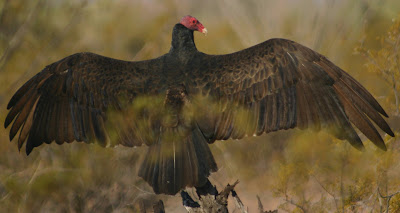Turkey vultures are a common sight in the desert. They are easily distinguished by their black and white wingfeathers, visible in their soaring flight above a moving car.
 I have seen many turkey vultures over the years, but I recently got my closest view in a trip to Organ Pipe Cactus National Monument in Southern Arizona.
I have seen many turkey vultures over the years, but I recently got my closest view in a trip to Organ Pipe Cactus National Monument in Southern Arizona. It was early morning, about 8:00 a.m., and I was driving home. I spotted one sitting in a tree and pulled the car over to see if I could get closer for a picture. As I got closer, I spotted a vulture closer to the ground standing on a tree stump.
It was early morning, about 8:00 a.m., and I was driving home. I spotted one sitting in a tree and pulled the car over to see if I could get closer for a picture. As I got closer, I spotted a vulture closer to the ground standing on a tree stump. 
They get the name "turkey" from their bare red head and dark plumage that resembles a male turkey.

It is a scavenger that feeds on carrion. It finds the carrion with keen vision and a great sense of smell. It can detect the gasses from dead animals just beginning to decay.

I was amazed to see this bird spread its wings and leave them like that. I have since learned that this helps dry the wings, particularly after damp or rainy nights, warms the body and bakes of the bacteria it gets from all those nasty carcasses.

As I got closer, this bird flew, and then I saw several other birds about 10 yards away, feeding on a piece of carrion. They flew and I took a closer look at a disgusting piece of rotting flesh which was probably a dead rabbit. Four of the vultures flew into a nearby tree, so I started out, slowly, to see how close I could get to them.
 It was fun to see several of them together.
It was fun to see several of them together. Eventually I got too close and they flew. So I got in the car and started for home again. Within a few minutes I spotted another cluster of turkey vultures sitting in a tree on the other side of the road, all with their wings outstretched, like an exercise class doing warmups. Again, I have since learned that they roost in large community groups, often in dead trees like the one below, then break away to forage independently during the day.
Eventually I got too close and they flew. So I got in the car and started for home again. Within a few minutes I spotted another cluster of turkey vultures sitting in a tree on the other side of the road, all with their wings outstretched, like an exercise class doing warmups. Again, I have since learned that they roost in large community groups, often in dead trees like the one below, then break away to forage independently during the day.  They are quite beautiful, in their own unique way. However, they do have some disgusting habits. For example, they defecate on their bald legs, letting the evaporation of the water in the feces and urine cool themselves. If a predator, such as a human, gets close enough, they will vomit in its face and eyes, which apparently stings quite a bit. They may also have to vomit an undigested meal in order to take flight if bothered while feeding.
They are quite beautiful, in their own unique way. However, they do have some disgusting habits. For example, they defecate on their bald legs, letting the evaporation of the water in the feces and urine cool themselves. If a predator, such as a human, gets close enough, they will vomit in its face and eyes, which apparently stings quite a bit. They may also have to vomit an undigested meal in order to take flight if bothered while feeding. All that being said, or perhaps because of it, they are still a fascinating animal. Wikipedia has a great article on them. They are year round residents in Organ Pipe, but are migratory birds further to the north, including Redlands. They migrate in large flocks and on several occasions I have seen them in groups of 40 or 50 soaring above Redlands, and once, about 20 or so roosting in the Eucalyptus trees near my office. Just this spring, Judy saw a migrating flock above our home.
All that being said, or perhaps because of it, they are still a fascinating animal. Wikipedia has a great article on them. They are year round residents in Organ Pipe, but are migratory birds further to the north, including Redlands. They migrate in large flocks and on several occasions I have seen them in groups of 40 or 50 soaring above Redlands, and once, about 20 or so roosting in the Eucalyptus trees near my office. Just this spring, Judy saw a migrating flock above our home.
I had a framed picture of a turkey vulture sitting on a fence that you took for a long time in my room that I loved. I wonder what happened to it?
ReplyDeleteSaw these in Pennsylvania a few years ago... they were perched on a fence with their wings partially spread. It was so eerie... and I always wondered why they were perched like that... now I know! :o)
ReplyDelete